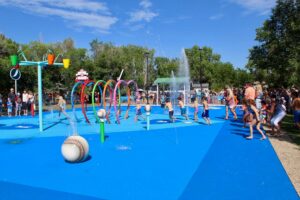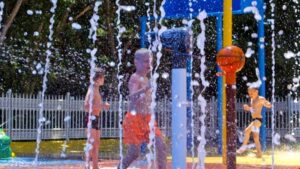The Rise of Community Splash Parks
Over the past decade, splash parks have become a cornerstone of community recreation. From urban centers to coastal resorts, municipalities and developers are recognizing the value of these inclusive, low-maintenance, and family-friendly spaces.
But creating a successful splash park isn’t just about choosing colorful features — it’s about smart design, reliable engineering, and strategic planning.
At Water Splash, our design-build approach ensures every project delivers on safety, functionality, and joy. Here’s what every community and developer should consider when planning a splash park.
1. Define the Vision Early
Before diving into layouts or budgets, identify who the splash park is for and what experience you want to create. Is it a neighborhood play zone? A destination feature within a larger park? A themed attraction complementing a resort or campground?
A clear vision guides design decisions — from water flow zones to age-appropriate play features and visual themes.
2. Choose the Right Site
A well-chosen location ensures accessibility, visibility, and operational efficiency. Key factors include:
- Proximity to amenities: restrooms, shade, and seating.
- Drainage and elevation: ensure surface water management.
- Utility access: reliable water and power supply simplify installation.
- Safety and supervision: open sightlines and soft surfaces.
3. Design for Flow — of People and Water
A great splash park balances interactive excitement and operational efficiency.
- Divide zones for toddlers, families, and thrill-seekers.
- Use smart manifolds and control systems for dynamic water play.
- Plan for sustainable flow rates to minimize water and energy consumption.
At Water Splash, our design engineers use 3D modeling and hydraulic simulation tools to optimize water distribution and minimize waste — without compromising fun.
4. Select the Right Water System: Recirculation or Drain-Away?
Your water management system defines long-term cost and maintenance:
- Recirculation systems are ideal for high-traffic parks, offering filtration and chemical balance for water reuse.
- Drain-away systems suit smaller or seasonal sites with simpler maintenance needs.
Local regulations, site size, and environmental objectives all play a role in choosing the right approach.
5. Plan for Maintenance and Longevity
Durable materials and proper winterization plans extend the life of your investment.
- Stainless steel manifolds, UV-resistant coatings, and anti-slip surfaces are essential.
- Incorporate accessible equipment rooms and automated control systems for easier upkeep.
- Seasonal maintenance programs, like those offered by Water Splash France and Water Splash North America, help protect your system year-round.
6. Partner with a Design-Build Expert
The most efficient way to achieve a successful splash park is through a design-build partnership. This approach integrates design, engineering, and installation — reducing miscommunication, ensuring code compliance, and delivering projects on time and within budget.
Water Splash’s turnkey solutions cover every step: from concept to commissioning. Our team ensures each site meets ASTM, EN, and ISO standards, and every play element is crafted for safety, accessibility, and delight.
Bringing Communities to Life
A splash park isn’t just an installation — it’s a space where communities connect, families laugh, and memories are made.
With thoughtful design, reliable engineering, and the right partners, your splash park can become a signature destination for years to come.
Water Splash – Design. Build. Play. Creating joyful aquatic experiences worldwide
Reach out to our team to start planning your next splash park project.
#WaterSplash #Splashpark #DesignBuild #AquaticPlay #CommunityDevelopment #MunicipalParks #WaterPlayExperts #PublicSpaces #LandscapeArchitecture #UrbanDesign






